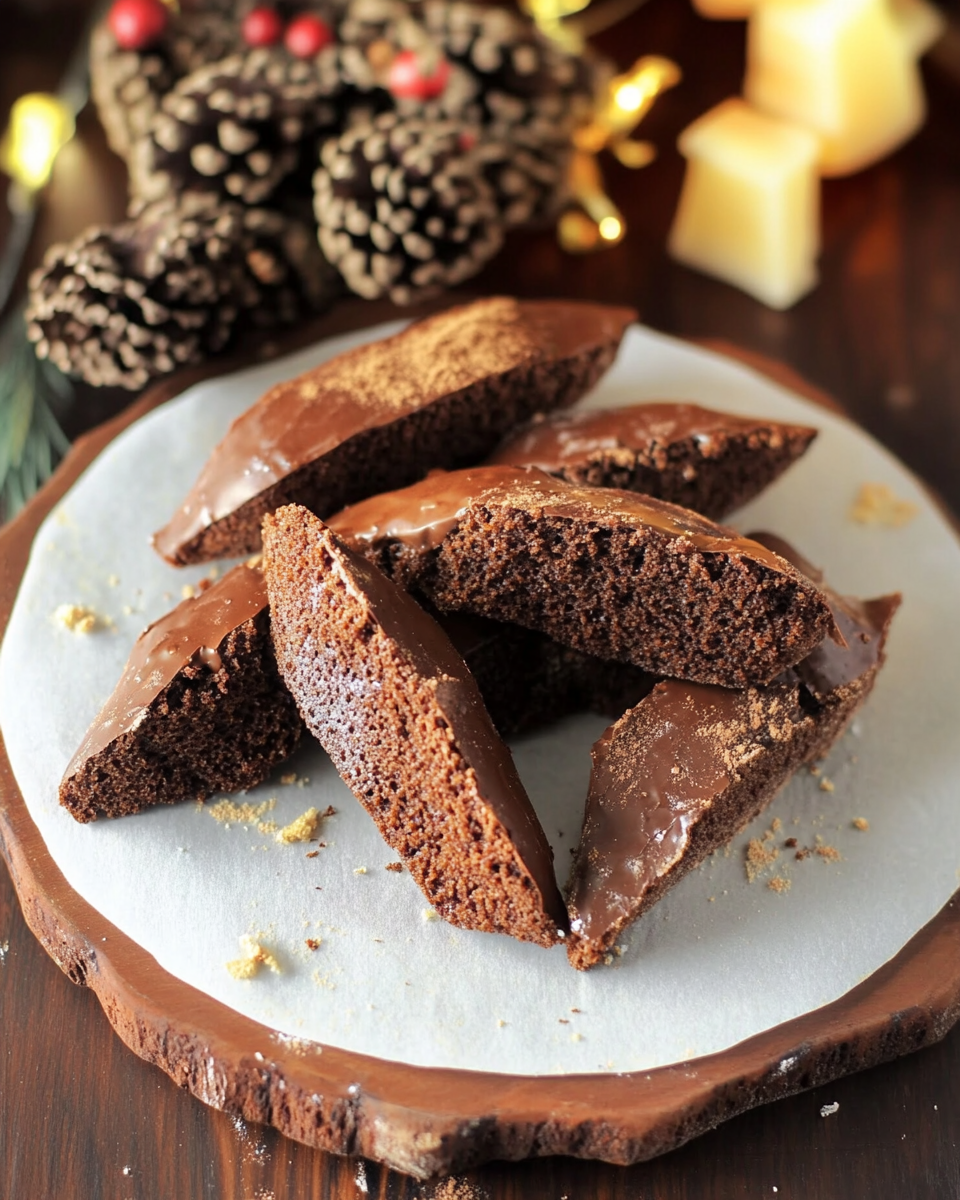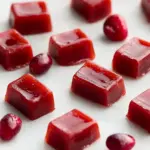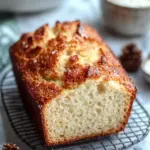Magenbrot is a quintessential German Christmas cookie that brings warmth and nostalgia to any winter table. With its tender, cake-like texture and richly spiced flavor, it resembles a cross between a cookie and gingerbread. The combination of cocoa, cinnamon, cloves, and nutmeg enveloped in a glossy sugar glaze creates a harmony of holiday flavors that are unmistakably festive and comforting. This traditional treat is a staple at European Christmas markets and is loved for its unique flavor and long shelf life. Magenbrot literally means “stomach bread,” referencing the historic belief that the spices aided digestion after hearty winter meals. It’s the perfect cookie to pair with mulled wine or spiced tea while wrapped in a cozy blanket. Whether baked for a festive cookie exchange, given as a homemade gift, or served at your holiday table, Magenbrot adds an irresistible old-world charm to your seasonal baking lineup.
Full Recipe:
Ingredients:
-
3 ½ cups all-purpose flour
-
1 tablespoon unsweetened cocoa powder
-
1 teaspoon baking powder
-
½ teaspoon baking soda
-
1 tablespoon cinnamon
-
1 teaspoon ground cloves
-
1 teaspoon ground nutmeg
-
½ teaspoon ground allspice
-
½ teaspoon salt
-
1 cup granulated sugar
-
½ cup honey
-
¼ cup unsalted butter
-
½ cup water
-
½ teaspoon vanilla extract
For the glaze:
-
1 cup confectioners’ sugar
-
2 tablespoons water
-
½ teaspoon cinnamon
Directions:
-
Preheat the oven to 350°F (175°C). Line a baking sheet with parchment paper.
-
In a large bowl, whisk together flour, cocoa powder, baking powder, baking soda, cinnamon, cloves, nutmeg, allspice, and salt.
-
In a saucepan, combine sugar, honey, butter, and water. Heat gently until melted and smooth. Remove from heat and stir in vanilla.
-
Pour the wet mixture into the dry ingredients and stir until combined into a thick dough.
-
Divide the dough into four equal parts. Roll each into a log, place on the baking sheet, and flatten slightly.
-
Bake for 15–20 minutes, then cool for 5 minutes. Cut logs diagonally into bite-sized pieces.
-
Mix confectioners’ sugar, cinnamon, and water into a thin glaze. Toss warm cookies in the glaze until coated.
-
Spread on a rack or tray to dry and set completely.
Prep Time: 20 minutes | Cooking Time: 20 minutes | Total Time: 40 minutes
Kcal: 110 kcal per piece | Servings: 40 pieces
A Taste of Tradition: The Story Behind Magenbrot
Magenbrot is one of those comforting, aromatic treats that instantly transports you to a snow-dusted European Christmas market, surrounded by the scent of roasted nuts, mulled wine, and spicy confections. This classic German cookie, which translates to “stomach bread,” is more than just a holiday sweet it’s a piece of culinary history, steeped in folklore and regional tradition. Characterized by its soft, cake-like texture and rich blend of spices like cinnamon, cloves, nutmeg, and allspice, Magenbrot is usually finished with a glossy sugar glaze that enhances its sweetness and festive charm.
Originating in southern Germany and Switzerland, Magenbrot has become a beloved staple at Christmas markets and winter fairs across the region. Its enduring popularity lies not just in its warm, spicy flavor but also in its supposed digestive benefits hence the name. The spices used in the cookie were once considered medicinal, intended to soothe the stomach after indulgent holiday feasting. Today, Magenbrot continues to be a favorite during the holiday season, cherished by families and food lovers for its nostalgic flavors and comforting aroma.
Cultural Origins and Historical Significance
Magenbrot’s history is deeply interwoven with the culture of German-speaking regions in Europe. Often compared to gingerbread, Magenbrot differs in its texture and subtle bitterness from cocoa powder, which sets it apart from other Christmas cookies. Its roots trace back to medieval times, when spices were used as both flavor enhancers and medicine. The name itself “Magen” meaning stomach and “brot” meaning bread points to its early role as a spiced bread intended to aid digestion, especially after consuming heavy or fatty meals typical of winter celebrations.
This cookie has traditionally been baked and sold at Weihnachtsmärkte (Christmas markets) across Germany, Austria, and Switzerland, where its sweet, spicy aroma mingles with that of roasted chestnuts and bratwurst. Many families in these regions have passed down their own versions of Magenbrot, with slight tweaks to the spice blend, sweetness level, and thickness of the glaze.
In Swiss-German dialect, it may also be known as “Lebkuchen,” though there are regional variations in shape, ingredients, and even method of glazing. While most Magenbrot recipes feature a classic combination of cinnamon, cloves, and cocoa, others include hints of cardamom, orange zest, or even anise. This diversity makes Magenbrot a truly personal and culturally rich cookie that connects generations through taste and memory.
Unique Characteristics of Magenbrot
What sets Magenbrot apart from more common holiday cookies is its soft, almost cake-like consistency. Unlike the snap of a gingerbread cookie or the chewiness of molasses cookies, Magenbrot has a tender bite, thanks to the leavening agents and the warm honey-sugar mixture used in the dough. The result is a sweet treat that’s rich without being overly dense or sticky.
Another distinctive element is the glaze. Rather than being just decorative, the sugar glaze adds texture, locks in moisture, and gives the cookies a slight crunch upon the first bite followed by the softness within. The glaze also serves a practical purpose: it allows the cookies to last longer, making them ideal for gift-giving or preparing in advance for holiday gatherings.
The flavor profile is unmistakably festive earthy from the cocoa, spicy from the cinnamon and cloves, and delicately sweet from the honey and sugar. Some versions include almonds or nuts for an extra layer of texture, while others keep the recipe simple to let the spice blend shine.
When and How to Enjoy Magenbrot
Magenbrot is traditionally enjoyed during the Advent season, often accompanied by a hot beverage like Glühwein (mulled wine), spiced cider, or a strong cup of black tea. Its warm spices and sugary coating make it a perfect counterbalance to the brisk chill of winter days.
Thanks to its firm-yet-moist structure, Magenbrot travels well and keeps for several days, making it an ideal treat for gift tins or as part of a larger holiday cookie platter. You might see it served at festive gatherings, school parties, or even wrapped in cellophane as part of a handmade gift basket.
For those looking to expand their holiday baking repertoire beyond the usual sugar cookies or chocolate chip classics, Magenbrot offers a delightful alternative that’s rooted in tradition but unfamiliar enough to feel new and exciting.
Modern Twists and Variations
While the traditional recipe remains popular, today’s home bakers and chefs have introduced modern twists to Magenbrot. Gluten-free versions, vegan adaptations using plant-based butters and agave syrup, and even chocolate-dipped renditions have made this heritage cookie accessible to more people.
In some households, bakers experiment with the spice levels, adjusting the warmth or sweetness to personal preference. Others go beyond the classic glaze by adding decorative sprinkles, edible gold dust, or drizzling with white chocolate to create an even more festive appearance. Some even incorporate dried fruits like raisins or cranberries to add chewiness and a hint of tartness.
Despite these innovations, the essence of Magenbrot remains the same a soft, spiced cookie that’s rich in tradition and flavor.
Baking Tips for Perfect Magenbrot
Though the process of making Magenbrot is relatively straightforward, a few tips can help ensure great results:
-
Let the Dough Rest: After mixing, allow the dough to rest for at least 30 minutes or chill it briefly. This helps the spices meld and makes shaping easier.
-
Watch the Bake Time: Don’t overbake; Magenbrot should be soft and moist inside. Check for doneness by lightly pressing the surface it should bounce back slightly.
-
Glaze While Warm: Toss the cookies in glaze while they’re still warm for better absorption and a shinier finish.
-
Store Properly: Once glazed and dried, store in an airtight container. These cookies improve in flavor after a day or two.
With these tips, even novice bakers can create a batch of Magenbrot that feels just like a trip to a Christmas market in Bavaria or Zurich.
Conclusion:
Magenbrot is more than just a holiday cookie it’s a culinary embodiment of warmth, nostalgia, and shared joy. Its roots in German-speaking Europe give it cultural weight, while its deliciously spiced flavor makes it timelessly appealing. Whether you’re baking a batch for family, preparing a holiday spread, or simply treating yourself to a comforting snack with tea, Magenbrot is sure to bring a sense of festivity and tradition to your table.
From its ancient origins as a digestive aid to its modern-day place in festive cookie tins and Instagram-worthy holiday spreads, Magenbrot has withstood the test of time. It is a wonderful way to honor tradition while savoring the cozy spirit of the season. So the next time you plan your holiday baking, consider adding this soft, spiced treasure to your list you just might find it becomes a new seasonal favorite in your own home.






